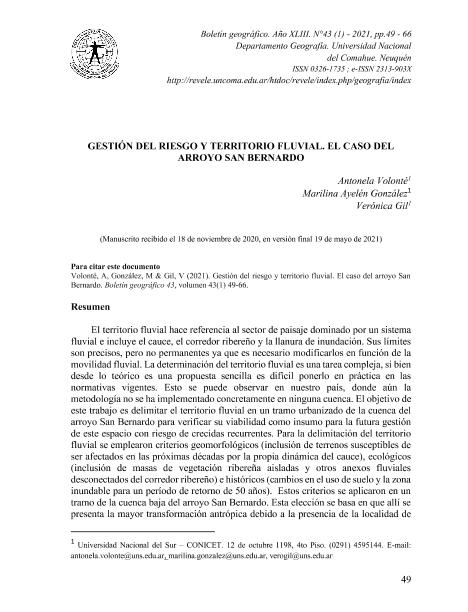Artículo
El territorio fluvial hace referencia al sector de paisaje dominado por un sistema fluvial e incluye el cauce, el corredor ribereño y la llanura de inundación. Sus límites son precisos, pero no permanentes ya que es necesario modificarlos en función de la movilidad fluvial. La determinación del territorio fluvial es una tarea compleja, si bien desde lo teórico es una propuesta sencilla es difícil ponerlo en práctica en las normativas vigentes. Esto se puede observar en nuestro país, donde aún la metodología no se ha implementado concretamente en ninguna cuenca. El objetivo de este trabajo es delimitar el territorio fluvial en un tramo urbanizado de la cuenca del arroyo San Bernardo para verificar su viabilidad como insumo para la futura gestión de este espacio con riesgo de crecidas recurrentes. Para la delimitación del territorio fluvial se emplearon criterios geomorfológicos (inclusión de terrenos susceptibles de ser afectados en las próximas décadas por la propia dinámica del cauce), ecológicos (inclusión de masas de vegetación ribereña aisladas y otros anexos fluviales desconectados del corredor ribereño) e históricos (cambios en el uso de suelo y la zona inundable para un período de retorno de 50 años). Estos criterios se aplicaron en un tramo de la cuenca baja del arroyo San Bernardo. Esta elección se basa en que allí se presenta la mayor transformación antrópica debido a la presencia de la localidad de Sierra de la Ventana. Considerando que el territorio fluvial es una herramienta que se ha utilizado en la gestión de los recursos hídricos, se considera oportuno empezar a aplicar la metodología en el tramo con mayor impacto para luego continuar con el resto de la cuenca. Como resultado se obtuvo un Territorio Fluvial Ideal (TFI) de 548 m2 en el cual es necesario gestionar las riberas ya que son los espacios más afectados por la antropización del área. The fluvial territory refers to the space or landscape dominated by a fluvial system and includes the channel, the riparian corridor and the flood plain. Its limits are precise, but not permanent since it is necessary to modify them according to river mobility. The determination of the river territory is a complex task, although from the theoretical point of view it is a simple proposal, it is very difficult to put it into practice, mainly in large basins. This can be observed in our country, where the methodology has not yet been concretely implemented in any basin. The objective of this work is to delimit the fluvial territory in an urbanized section of the San Bernardo stream basin to be used as an input for the future management of this space in the face of the problem of floods that repeatedly affect the area. For the delimitation of the river territory, geomorphological (inclusion of land susceptible to being eroded in the coming decades due to the dynamics of the riverbed), ecological (inclusion of isolated riverine vegetation masses and other fluvial annexes disconnected from the riverine corridor) and historical criteria were used (changes in land use and floodplain for a return period of 50 years). These criteria were applied in a section of the lower basin of the San Bernardo stream. This choice is based on the fact that there is the greatest impact given the presence of the town of Sierra de la Ventana. Considering that, the river territory is a tool that can be used in the incipient management of water resources that is being carried out in the basin, it is considered appropriate to start applying the methodology in the section with the greatest impact and then continue with the rest of the basin. As a result, an Ideal Fluvial Territory of 548 m2 was obtained in which it is necessary to manage the banks since they are the spaces most affected by the anthropization of the area.
Gestión del riesgo y territorio fluvial: El caso del arroyo San Bernardo
Título:
Management of riesgo and fluvial territory: Case of the San Bernardo stream
Fecha de publicación:
11/2021
Editorial:
Universidad Nacional del Comahue. Facultad de Humanidades. Departamento de Geografía
Revista:
Boletín geográfico
ISSN:
0326-1735
e-ISSN:
2313-903X
Idioma:
Español
Tipo de recurso:
Artículo publicado
Clasificación temática:
Resumen
Palabras clave:
TERRITORIO FLUVIAL
,
USOS DEL SUELO
,
RIESGO
,
CUENCAS PEQUEÁS
Archivos asociados
Licencia
Identificadores
Colecciones
Articulos(CCT - BAHIA BLANCA)
Articulos de CTRO.CIENTIFICO TECNOL.CONICET - BAHIA BLANCA
Articulos de CTRO.CIENTIFICO TECNOL.CONICET - BAHIA BLANCA
Citación
Volonté, Antonela; González, Marilina Ayelén; Gil, Veronica; Gestión del riesgo y territorio fluvial: El caso del arroyo San Bernardo; Universidad Nacional del Comahue. Facultad de Humanidades. Departamento de Geografía; Boletín geográfico; 43; 1; 11-2021; 49-66
Compartir




